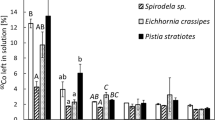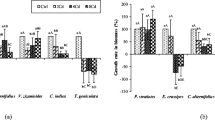Abstract
Mercury (Hg) is a prevalent and harmful contaminant that persists in the environment. For phytoremediation, it is important to discover which plants can bioaccumulate meaningful amounts of Hg while also tolerating its toxicity. Additionally, increasing biodiversity could create a more resilient and self-sustaining system for remediation. This study explores whether mixed populations of Lemna minor and Spirodela polyrhiza can better bioaccumulate and tolerate Hg than monocultures. Mono- and mixed cultures of L. minor and S. polyrhiza were grown in mesocosms of 0.5 µg/L or 100 µg/L Hg (HgCl2) spiked water for 96 h. Change in weight of duckweed was used to assess Hg tolerance. Diffusive gradients in thin-films (DGTs) were used as surrogate monitoring devices for bioavailable levels of Hg. For biomass growth, the mixed culture of the L. minor was greater than the monoculture at the high dose. The L. minor accumulated more Hg in the mixed culture at the low dose while the S. polyrhiza was higher in the mixed at the high dose. Hg speciation in water was modeled using Windermere Humic Aqueous Model 7 (WHAM7) to compare the bioavailable species indicated by the DGTs. Potentially due to the controlled conditions, the WHAM7 output of bioavailable Hg was almost 1:1 to that estimated by the DGTs, indicating good predictive capability of geochemical modeling and passive sampler DGT on metal bioavailability. Overall, the mixed cultures statistically performed as well as or better than the monocultures when tolerating and bioaccumulating Hg. However, there needs to be further work to see if the significant differences translate into practical differences worth the extra resources to maintain multiple species.




Similar content being viewed by others
Data availability
Data is available from the corresponding author upon request.
References
Amundsen PA, Henriksson M, Poste A, Prati S, Power M (2023) Ecological drivers of mercury bioaccumulation in fish of a subarctic watercourse. Environ Toxicol Chem 42(4):873–887. https://doi.org/10.1002/etc.5580
Appenroth KJ, Sree KS, Fakhoorian T, Lam E (2015) Resurgence of duckweed research and applications: report from the 3rd International Duckweed Conference. Plant Mol Biol 89(6):647–654. https://doi.org/10.1007/s11103-015-0396-9
Baudo R, Foudoulakis M, Arapis G, Perdaen K, Lanneau W, Paxinou ACM et al. (2015) History and sensitivity comparison of the Spirodela polyrhiza microbiotest and Lemna toxicity tests. Knowl Manag Aquat Ec (416). https://doi.org/10.1051/kmae/2015019
Coughlan NE, Kelly TC, Jansen MAK (2015) Mallard duck (Anas platyrhynchos)-mediated dispersal of Lemnaceae: a contributing factor in the spread of invasive Lemna minuta? Plant Biol 17:108–114. https://doi.org/10.1111/plb.12182
Davison W, Zhang H (1994) In-situ speciation measurements of trace components in natural-waters using thin-film gels. Nature 367(6463):546–548. https://doi.org/10.1038/367546a0
Davison W (2016) Diffusive gradients in thin-films for environmental measurements. Cambridge, UK. Cambridge University Press (Cambridge Environmental Chemistry Series). https://doi.org/10.1017/CBO9781316442654
Dirilgen N (2011) Mercury and lead: assessing the toxic effects on growth and metal accumulation by Lemna minor. Ecotoxicol Environ Saf 74(1):48–54. https://doi.org/10.1016/j.ecoenv.2010.09.014
Dong WM, Liang LY, Brooks S, Southworth G, Gu BH (2010) Roles of dissolved organic matter in the speciation of mercury and methylmercury in a contaminated ecosystem in Oak Ridge, Tennessee. Environ Chem 7(1):94–102. https://doi.org/10.1071/EN09091
Driever SM, van Nes EH, Roijackers RMM (2005) Growth limitation of Lemna minor due to high plant density. Aquat Bot 81(3):245–251. https://doi.org/10.1016/j.aquabot.2004.12.002
Ekperusi AO, Sikoki FD, Nwachukwu EO (2019) Application of common duckweed (Lemna minor) in phytoremediation of chemicals in the environment: state and future perspective. Chemosphere 223:285–309. https://doi.org/10.1016/j.chemosphere.2019.02.025
Gentes S, Lohrer B, Legeay A, Mazel AF, Anschutz P, Charbonnier C et al. (2021) Drivers of variability in mercury and methylmercury bioaccumulation and biomagnification in temperate freshwater lakes. Chemosphere 267. https://doi.org/10.1016/j.chemosphere.2020.128890
Gupta C, Prakash D (2013) Duckweed: an effective tool for phyto-remediation. Toxicol Environ Chem 95(8):1256–1266. https://doi.org/10.1080/02772248.2013.879309
Isaksson R, Balogh SJ, Farris MA (2006) Accumulation of mercury by the aquatic plant Lemna minor. Int J Environ Stud 64(2):189–194. https://doi.org/10.1080/00207230701238556
Kafle A, Timilsina A, Gautam A, Adhikari K, Bhattarai A, Aryal N (2022) Phytoremediation: mechanisms, plant selection and enhancement by natural and synthetic agents. Environ Adv 8:100203. https://doi.org/10.1016/j.envadv.2022.100203
Kutschera U, Niklas KJ (2015) Darwin-Wallace Demons: survival of the fastest in populations of duckweeds and the evolutionary history of an enigmatic group of angiosperms. Plant Biol 17:24–32. https://doi.org/10.1111/plb.12171
Lemon GD, Posluszny U, Husband BC (2001) Potential and realized rates of vegetative reproduction in Spirodela polyrhiza, Lemna minor, and Wolffia borealis. Aquat Bot 70(1):79–87. https://doi.org/10.1016/S0304-3770(00)00131-5
Li F, Ma CM, Zhang PJ (2020) Mercury deposition, climate change and anthropogenic activities: a review. Front Earth Sc-Switz 8. https://doi.org/10.3389/feart.2020.00316
Liu ZC, Tran KQ (2021) A review on disposal and utilization of phytoremediation plants containing heavy metals. Ecotoxicol Environ Saf 226. https://doi.org/10.1016/j.ecoenv.2021.112821
Pacyna JM (2020) Recent advances in mercury research. Sci Total Environ 738. https://doi.org/10.1016/2Fj.scitotenv.2020.139955
Pelcova P, Kopp R, Ridoskova A, Grmela J, Sterbova D (2022) Evaluation of mercury bioavailability and phytoaccumulation by means of a DGT technique and of submerged aquatic plants in an aquatic ecosystem situated in the vicinity of a cinnabar mine. Chemosphere 288. https://doi.org/10.1016/j.chemosphere.2021.132545
Quijas S, Schmid B, Balvanera P (2010) Plant diversity enhances provision of ecosystem services: a new synthesis. Basic Appl Ecol 11(7):582–593. https://doi.org/10.1016/j.baae.2010.06.009
Romero-Hernandez JA, Amaya-Chavez A, Balderas-Hernandez P, Roa-Morales G, Gonzalez-Rivas N, Balderas-Plata MA (2017) Tolerance and hyperaccumulation of a mixture of heavy metals (Cu, Pb, Hg, and Zn) by four aquatic macrophytes. Int J Phytoremediat 19(3):239–245. https://doi.org/10.1080/15226514.2016.1207610
Safe Water Drinking Water Act (1974) 88 Stat. 1660. S433. 93rd Congress, 2nd Session, 1974 ed. United States 1660–1694. Accessed 13 January 2024
Singh H, Kumar D, Soni V (2020) Copper and mercury induced oxidative stresses and antioxidant responses of Spirodela polyrhiza (L.) Schleid. Biochem Biophys Rep 23:100781. https://doi.org/10.1016/j.bbrep.2020.100781
Strzalek M, Kufel L (2021) Light intensity drives different growth strategies in two duckweed species: Lemna minor L. and Spirodela polyrhiza (L.) Schleiden. Peerj 9. https://doi.org/10.7717/peerj.12698
Su YY, Mennerich A, Urban B (2012) Coupled nutrient removal and biomass production with mixed algal culture: impact of biotic and abiotic factors. Bioresour Technol 118:469–476. https://doi.org/10.1016/j.biortech.2012.05.093
Tang WL, Liu YR, Guan WY, Zhong H, Qu XM, Zhang T (2020) Understanding mercury methylation in the changing environment: recent advances in assessing microbial methylators and mercury bioavailability. Sci Total Environ 714:136827. https://doi.org/10.1016/j.scitotenv.2020.136827
Thorne LH, Fuirst M, Veit R, Baumann Z (2021) Mercury concentrations provide an indicator of marine foraging in coastal birds. Ecol Indic 121. https://doi.org/10.1016/j.ecolind.2020.106922
U.S.EPA (1994) Method 200.8: determination of trace elements in waters and wastes by inductively coupled plasma-mass spectrometry. Revision 5.4. Cincinnati, OH. https://www.epa.gov/esam/epa-method-2008-determination-trace-elements-waters-and-wastes-inductively-coupled-plasma-mass. Accessed 27 Jan 2024
U.S.EPA (1998) Method 7473 (SW-846): mercury in solids and solutions by thermal decomposition, amalgamation, and atomic absorption spectrophotometry. Revision 0. Washington, DC. https://www.epa.gov/esam/epa-method-7473-sw-846-mercury-solids-and-solutions-thermal-decomposition-amalgamation-and. Accessed 27 Jan 2024
Walsh E, Kuehnhold H, O’Brien S, Coughlan NE, Jansen MAK (2021) Light intensity alters the phytoremediation potential of Lemna minor. Environ Sci Pollut R 28(13):16394–16407. https://doi.org/10.1007/s11356-020-11792-y
Wang Y, Liu J, Liem-Nguyen V, Tian S, Zhang S, Wang D et al (2022) Binding strength of mercury (II) to different dissolved organic matter: the roles of DOM properties and sources. Sci Total Environ 807(Pt 3):150979. https://doi.org/10.1016/j.scitotenv.2021.150979
Wedge RM, Burris JE (1982) Effects of light and temperature on duckweed photosynthesis. Aquat Bot 13(2):133–140. https://doi.org/10.1016/0304-3770(82)90047-X
Wollenberg JL, Peters SC (2009) Diminished mercury emission from waters with duckweed cover. J Geophys Res-Biogeo 114. https://doi.org/10.1029/2008JG000770
Xu XY, Bryan AL, Mills GL, Korotasz AM (2019) Mercury speciation, bioavailability, and biomagnification in contaminated streams on the Savannah River Site (SC, USA). Sci Total Environ 668:261–270. https://doi.org/10.1016/j.scitotenv.2019.02.301
Yang JJ, Li GJ, Bishopp A, Heenatigala PPM, Hu SQ, Chen Y et al (2018) A comparison of growth on mercuric chloride for three Lemnaceae species reveals differences in growth dynamics that effect their suitability for use in either monitoring or remediating ecosystems contaminated with mercury. Front Chem 6. https://doi.org/10.3389/fchem.2018.00112
Zhang TT, Lu QQ, Su CL, Yang YR, Hu D, Xu QS (2017) Mercury induced oxidative stress, DNA damage, and activation of antioxidative system and Hsp70 induction in duckweed (Lemna minor). Ecotoxicol Environ Saf 143:46–56. https://doi.org/10.1016/j.ecoenv.2017.04.058
Zhao Z, Shi HJ, Liu Y, Zhao H, Su HF, Wang ML et al (2014) The influence of duckweed species diversity on biomass productivity and nutrient removal efficiency in swine wastewater. Bioresour Technol 167:383–389. https://doi.org/10.1016/j.biortech.2014.06.031
Zhao Z, Shi HJ, Duan DZ, Li HM, Lei TW, Wang ML et al (2015) The influence of duckweed species diversity on ecophysiological tolerance to copper exposure. Aquat Toxicol 164:92–98. https://doi.org/10.1016/j.aquatox.2015.04.019
Zhao Z, Shi HJ, Liu CQ, Kang XJ, Chen LC, Liang XF et al (2018) Duckweed diversity decreases heavy metal toxicity by altering the metabolic function of associated microbial communities. Chemosphere 203:76–82. https://doi.org/10.1016/j.chemosphere.2018.03.175
Acknowledgements
We would like to thank Angela Lindell for analytical training and consultation and Erin Peck for safety and waste disposal.
Funding
This material is based upon work supported by the Department of Energy under Award Number DE-EM0004391 to the University of Georgia Research Foundation.
Author information
Authors and Affiliations
Contributions
Conceptualization, methodology, and investigation: Breann Spencer and Xiaoyu Xu; Software, validation, writing—original draft preparation, visualization: Breann Spencer; Editing: Zeinah Baddar and Xiaoyu Xu; Resources, supervision, project administration, and funding acquisition: Xiaoyu Xu; Formal analysis and methodology: Breann Spencer and Xiaoyu Xu; Data collection: Breann Spencer and Zeinah Baddar; all authors have read and agreed to the published version of the manuscript.
Corresponding author
Ethics declarations
Ethical approval
Not applicable.
Consent to participate
Not applicable.
Consent for publication
Not applicable.
Competing interests
The authors declare no competing interests.
Disclaimer
This report was prepared as an account of work sponsored by an agency of the United States Government. Neither the United States Government nor any agency thereof, nor any of their employees, makes any warranty, express or implied, or assumes any legal liability or responsibility for the accuracy, completeness, or usefulness of any information, apparatus, product, or process disclosed, or represents that its use would not infringe privately owned rights. Reference herein to any specific commercial product, process, or service by trade name, trademark, manufacturer, or otherwise does not necessarily constitute or imply its endorsement, recommendation, or favoring by the United States.
Additional information
Responsible Editor: Roberto Terzano
Publisher's Note
Springer Nature remains neutral with regard to jurisdictional claims in published maps and institutional affiliations.
Rights and permissions
Springer Nature or its licensor (e.g. a society or other partner) holds exclusive rights to this article under a publishing agreement with the author(s) or other rightsholder(s); author self-archiving of the accepted manuscript version of this article is solely governed by the terms of such publishing agreement and applicable law.
About this article
Cite this article
Spencer, B.S., Baddar, Z.E. & Xu, X. Comparison of mercury (Hg) bioaccumulation with mono- and mixed Lemna minor and Spirodela polyrhiza cultures. Environ Sci Pollut Res 31, 35055–35068 (2024). https://doi.org/10.1007/s11356-024-33583-5
Received:
Accepted:
Published:
Issue Date:
DOI: https://doi.org/10.1007/s11356-024-33583-5




